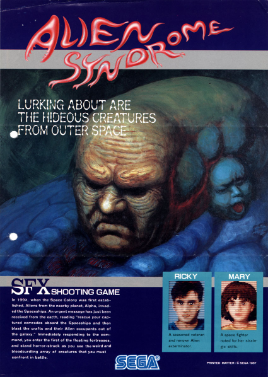
Alien Syndrome is a run and gun video game developed by Sega and released in arcades in 1987, and later ported to the Master System in 1988. The game utilizes a side-scrolling feature that allows the player to take control of either a male (Ricky) or female (Mary) soldier whilst hunting aliens and saving hostages before they run out of time.

Shinobi (忍) is a side-scrolling hack and slash video game produced by Sega, originally released for arcades on the Sega System 16 board in 1987. The player controls ninja Joe Musashi, to stop the Zeed terrorist organization from kidnapping students of his clan.

Ikari Warriors, known as Ikari in Japan, is a vertically scrolling run and gun video game released for arcades by SNK in 1986. It was published in North America by Tradewest. At the time there were many Commando clones on the market. What distinguished Ikari Warriors were rotary joysticks and a two-player cooperative mode. The rotary joystick controls were in turn based on SNK's earlier TNK III (1985). Ikari was originally intended to be an official licensed adaptation of the film Rambo: First Blood Part II (1985), but SNK were initially unable to acquire the rights to the film.

Operation Wolf is a light gun shooter arcade game developed by Taito and released in 1987. It was ported to many home systems.

Commando, released as Senjō no Ōkami in Japan, is a vertically scrolling run and gun video game released by Capcom for arcades in 1985. The game was designed by Tokuro Fujiwara. It was distributed in North America by Data East, and in Europe by several companies including Capcom, Deith Leisure and Sega, S.A. SONIC. Versions were released for various home computers and video game consoles. It is unrelated to the 1985 film of the same name, which was released six months after the game.

Golden Axe is a side-scrolling hack-and-slash video game released by Sega for arcades in 1989, running on the Sega System 16B arcade hardware. Makoto Uchida was the lead designer of the game, and was also responsible for the creation of the previous year's Altered Beast. The game casts players as one of three warriors who must free the fantastical land of Yuria from the tyrannical rule of Death Adder, who wields the titular Golden Axe.
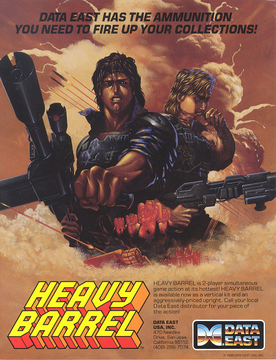
Heavy Barrel is a 1987 overhead run and gun arcade game by Data East.
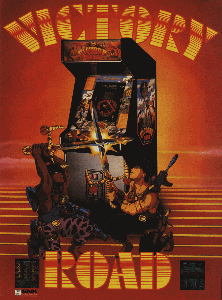
Victory Road, also known as Dogō Sōken in Japan and Ikari Warriors II: Victory Road in North America, is a run and gun video game released by SNK for arcades in 1986. The game is a sequel to Ikari Warriors, released earlier the same year.

Ikari III: The Rescue, simply known as Ikari III (怒III) in Japan, is a 1989 arcade run & gun shoot 'em up beat 'em up game developed and published by SNK. It was ported to the NES, IBM PC compatibles, and Commodore 64. It is the third and final installment of the Ikari Warriors series after Ikari Warriors and Victory Road. The NES version was shown at the 1991 CES.

Jackal, also distributed under the title of Top Gunner, is an overhead run and gun video game released for arcades by Konami in 1986. The player must maneuver an armed jeep in order to rescue prisoners of war (POWs) trapped in enemy territory.

Guerrilla War, released in Japan as Guevara (ゲバラ), is an overhead run and gun video game developed and published by SNK. Originally released in 1987 as a coin-operated arcade game, Guerrilla War was ported to the Amstrad CPC, Apple II, Commodore 64, MS-DOS, Nintendo Entertainment System, PlayStation Network, and ZX Spectrum.

Metal Slug is a Japanese multimedia franchise and run and gun video game series originally created by Nazca Corporation before merging with SNK in 1996 after the completion of the first game in the series. Spin-off games include a third-person shooter to commemorate the 10th anniversary of the series and a tower defense game for the mobile platform. While originally created for Neo-Geo arcade machines hardware (MVS) and the Neo-Geo home game consoles (AES) hardware, the original games have also been ported to other consoles and mobile platforms throughout the years, with several later games created for various other platforms. The games focus on the Peregrine Falcon Squad, a small group of soldiers who fight against a rebel army, aliens, zombies, mummies and various other forces intent on world domination. Over the years since its debut, The franchise developed a small, but passionate cult following due to its unique visuals and slapstick humor.

Mercs, originally released as Senjō no Ōkami II in Japan, is a run and gun video game developed and published in arcades by Capcom in 1990. It is a sequel to the 1985 arcade video game Commando. While not as successful as its predecessor, Mercs was well received by critics and was a moderate commercial success. It was followed by Wolf of the Battlefield: Commando 3 in 2008, a downloadable game.

Midnight Resistance is a side-scrolling run and gun game produced by Data East and released in arcades in 1989. Midnight Resistance is set in a dystopian future where the player controls a member of a resistance movement who goes on a mission to rescue his kidnapped family from a drug kingpin.
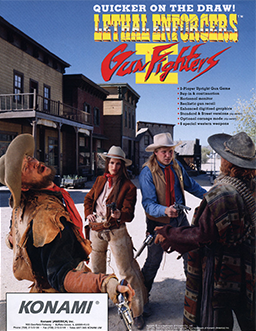
Lethal Enforcers II: Gun Fighters, known in Japan as Lethal Enforcers 2: The Western, is a 1994 light gun shooter arcade game and a prequel to the original Lethal Enforcers. In contrast with the first game's modern law enforcement theme, Lethal Enforcers II takes place in the American Old West.
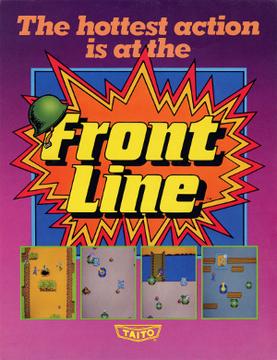
Front Line is a military-themed run and gun video game released by Taito for arcades in November 1982. It was one of the first overhead run and gun games, a precursor to many similarly-themed games of the mid-to-late 1980s. Front Line is controlled with a joystick, a single button, and a rotary dial that can be pushed in like a button. The single button is used to throw grenades and to enter and exit tanks, while the rotary dial aims and fires the player's gun.

Rambo III is a series of video games based on the film Rambo III (1988). Like in the film, their main plots center on former Vietnam-era Green Beret John Rambo being recalled up to duty one last time to rescue his former commander, Colonel Sam Trautman, who was captured during a covert operation mission in Soviet-controlled Afghanistan. Taito released an arcade video game based on the film. The console versions were developed and published by Sega, the IBM PC compatible version was developed by Ocean and published by Taito, and Ocean developed and published the other home computer versions: Atari ST, Amiga, Spectrum, C64, Amstrad CPC.
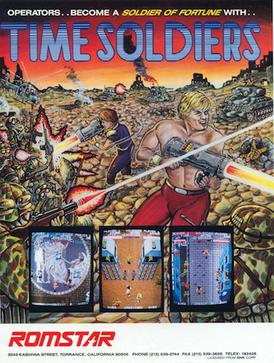
Time Soldiers, known in Japan as Battle Field, is a 1987 run and gun video game developed by Alpha Denshi for arcades and published by SNK. It was distributed in North America by Romstar. A Master System version was also produced, as well as versions titled Time Soldier for the Amiga, Commodore 64, and Atari ST.

Thunder Blade is a third-person shoot 'em up video game released by Sega for arcades in 1987. Players control a helicopter to destroy enemy vehicles. The game was released as a standard stand-up arcade cabinet with force feedback, as the joystick vibrates. A helicopter shaped sit-down model was released, replacing the force feedback with a cockpit seat that moves in tandem with the joystick. It is a motion simulator cabinet, like the previous Sega Super Scaler games Space Harrier (1985) and After Burner (1987). The game's plot and setting was inspired by the film Blue Thunder (1983).

T.A.N.K. is a 1985 vertically scrolling multidirectional shooter developed and released in arcades by SNK. It was published in North America as TNK III by Kitcorp. Versions of T.A.N.K. for home computers were released by Ocean Software for the ZX Spectrum, Commodore 64, and Amstrad CPC in 1987. A sequel was also released for the Nintendo Entertainment System titled Iron Tank.





















